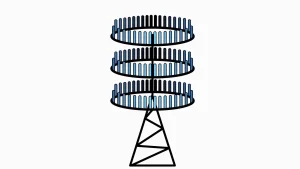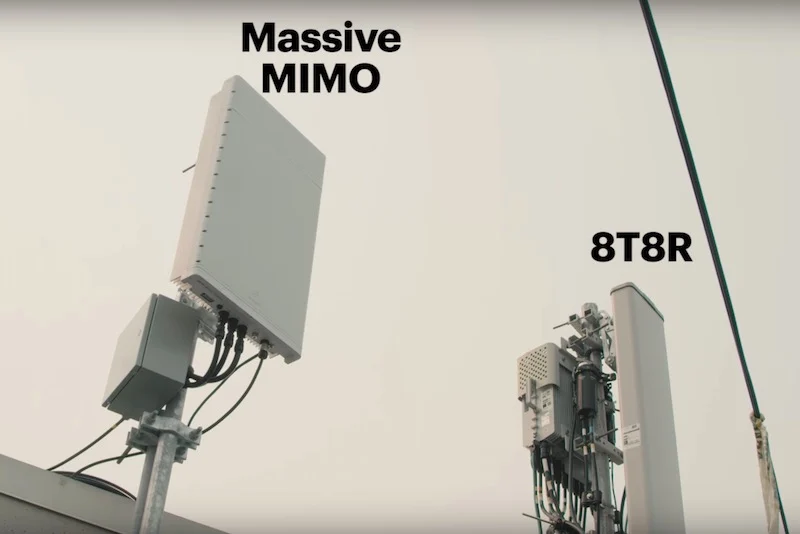The intricacies of wireless communication are many, and none more essential than beamforming in MIMO systems. The ability to create a directed signal from an antenna towards the intended receiver is paramount for increasing signal strength and reducing interference.

In the ever-evolving world of 5G networks, hybrid digital and analog beamforming techniques have become all the rage. Their capacity to provide high data rates with low latency has propelled them into popularity. Utilizing both digital and analog methods creates optimal performance in MIMO systems.
Massive MIMO technology combined with beamforming has also emerged as key players in improving wireless communication systems. Imagine hundreds or even thousands of antennas at base stations working together to enhance spectral efficiency! Meanwhile, beamforming fine-tunes signals towards specific users or devices, leading to stellar network performance overall. It’s quite perplexing how these technologies burst onto the scene but continue to amaze us every day!
The Role of Beamforming in Wireless Communication
Contents
- 1 The Role of Beamforming in Wireless Communication
- 2 Hybrid Digital and Analog Beamforming Techniques in MIMO Systems
- 3 An Overview of Massive MIMO and Beamforming for Systems
- 4 Designing and Implementing Analog Beamforming for Large-Scale MIMO Systems
- 5 Signal Processing Algorithms for Digital Beamforming in MIMO Systems
- 6 Antenna Array Design for Efficient Beamforming in Wireless Communication Systems
- 7 Enhancing Beamforming Techniques for Improved Performance in MIMO Systems
As the wireless communication landscape continues to evolve, one technique that has proven to be indispensable is beamforming. With its ability to expertly direct radio waves towards specific targets through an array of antennas, this technique not only enhances signal quality but also reduces interference. And with analog and digital implementations available, it’s no wonder why beamforming holds such a crucial role in modern systems.

But as we move towards 5G networks and beyond, the need for high-speed data transmission becomes more pressing than ever before. Enter large-scale MIMO systems: these behemoths employ hundreds or even thousands of antenna elements in order to support multiple users at once. And naturally, beamforming plays a vital part in making sure that spatial multiplexing can occur without inter-user interference wreaking havoc on the system.
And if you thought massive MIMO was impressive before…well, just wait until you hear about how they use beamforming! Equipped with hundreds or thousands of antennas each, base stations powered by this emerging technology are capable of serving countless users simultaneously while still maintaining lightning-fast data rates. But make no mistake: effective algorithms and smart antenna design will be absolutely critical if massive MIMO is going to live up to its potential.
Hybrid Digital and Analog Beamforming Techniques in MIMO Systems
The realm of 5G wireless communication has been inundated with a plethora of promising solutions to improve massive MIMO systems. Among these budding techniques, hybrid beamforming has emerged as an exceptional choice. This technique amalgamates the advantages of both analog and digital beamforming techniques to surmount their individual limitations.
In essence, the RF chain is bifurcated into two segments: one for analog beamforming and another for digital beamforming. The former facilitates coarse-grained beamforming using fewer RF chains, thereby reducing hardware complexity and power consumption. Conversely, the latter refines transmit beams by processing multiple antenna streams utilizing signal processing algorithms – resulting in efficient interference management and enhanced spectral efficiency.
To implement this method in an antenna array demands meticulous design considerations that optimize performance while minimizing costs. An obstacle encountered during execution is selecting optimal combinations of analog and digital weights that achieve maximum radiation pattern gain without causing significant inter-antenna element interference or coupling from adjacent antennas or reflections from nearby objects.
Notwithstanding these challenges, hybrid digital-analog beamforming remains an efficient way to enhance MIMO system performance without compromising on power consumption or hardware complexity. Researchers can further augment its capabilities by combining different methodologies like algorithm optimization, transmit precoding, channel estimation etc., towards achieving high throughput rates with low latency requirements in future wireless communication networks – confounding yet exciting times lie ahead!
An Overview of Massive MIMO and Beamforming for Systems
Massive MIMO and beamforming have taken the wireless communication world by storm, revolutionizing its very foundations. These two technologies combine to transmit multiple data streams simultaneously, resulting in a capacity boost and superior system performance.
When it comes to massive MIMO beamforming systems, base stations equipped with numerous antennas transmit signals using various beamforming vectors for several users. The phase shifters connected to each antenna element adjust these beams’ focus energy toward the desired user while minimizing interference from other users – a seemingly perplexing yet efficient resource utilization technique.
Hybrid digital and analog beamforming is another favored approach employed in massive MIMO systems. It involves utilizing both digital and analog components for designing the beamforming antennas. Baseband processing occurs digitally, whereas analog processing takes place at RF frequencies using phase shifters or variable gain amplifiers – an explosively bursty method that reduces complexity and power consumption compared to fully digital designs.
Designing an analog beamforming system for large-scale MIMO requires meticulous consideration of various factors such as antenna placement, array geometry, inter-element spacing et cetera before optimal performance can be achieved. Extensive use of MATLAB simulations during design evaluation is highly recommended before implementation.
To summarize: Massive MIMO combined with Beamforming techniques offers significant benefits over traditional wireless communication systems due to smarter antenna designs enabling high-capacity data transmission with reduced interference levels. Digital and Analog Beamforming Design plays a crucial role in achieving optimal performance when implementing these smart technologies into practical applications – a truly mind-boggling phenomenon!
Designing and Implementing Analog Beamforming for Large-Scale MIMO Systems
The art of wireless communication systems is a perplexing one indeed. Analog beamforming, a technique used to boost the quality of transmitted signals, operates by utilizing beamforming antenna arrays that focus transmission in a specific direction while reducing interference from other sources. The number of antennas available determines how many beams can be formed and directed towards different users.
This approach is not restricted to any particular frequency band; millimeter-wave frequencies are just as susceptible to analog beamforming’s charm. To further bolster performance in large-scale MIMO systems, digital and hybrid techniques can pair well with analog beamforming.
Transmitting using this method has its advantages too – improved signal-to-noise ratio (SNR) at the receiver end being one such benefit; more power is directed towards it through transmit beamforming.
But there’s no denying it: designing an efficient system for analog beamforming when multiple users or interference sources are present poses quite the challenge. It requires careful consideration of both transmit and receive processing algorithms. Nevertheless, implementing this technique has proven to significantly improve system capacity and spectral efficiency compared to traditional omnidirectional approaches.
Signal Processing Algorithms for Digital Beamforming in MIMO Systems
The world of MIMO communications is a perplexing labyrinth where digital beamforming reigns supreme. This technique holds the key to controlling the radiation pattern from an antenna array, but with fixed and adaptive categories, one can’t help but feel overwhelmed. And let’s not forget about hybrid beamforming design – it’s all the rage for 5G base station implementations.
By manipulating transmitted power directionality, digital beamforming unlocks the potential for massive MIMO systems to reach unprecedented levels of performance. But wait, there’s more! Multi-user MIMO applications benefit greatly from this technique as well. By using different antenna ports that serve multiple users simultaneously while mitigating interference between them, spectral efficiency skyrockets and system capacity increases in bursts.
But don’t get too excited just yet – efficient antenna array design plays a crucial role in achieving optimal results through beamforming techniques. Element spacing and polarization diversity are just some of the factors that must be taken into consideration when aiming for success in wireless communication systems.
And if you thought things couldn’t get any more complicated than they already are – think again! In high-frequency 5G systems that utilize increased bandwidths, radiation pattern control becomes even more paramount through advanced signal processing algorithms to ensure reliable communication links at these frequencies.
Antenna Array Design for Efficient Beamforming in Wireless Communication Systems
The intricate design of antenna arrays is vital in achieving optimal beamforming for wireless communication systems. Utilizing large arrays with multiple elements enables signals to be transmitted and received from various directions, ultimately supporting high data rates over the communication link.
However, precise beamforming requires independent control of each array element by adjusting both its magnitude and phase. Signal processing algorithms are employed to estimate channel characteristics between transmitter and receiver, allowing digital antennas to adjust their overall pattern based on these estimated conditions.
Mutual coupling is a significant consideration when designing large antenna arrays as it affects individual radiation patterns and transmission efficacy. To mitigate mutual coupling effects and enhance overall performance, techniques such as spatial smoothing can be implemented. Additionally, while reducing antenna spacing may help reduce mutual coupling effects, this may necessitate more complex estimation methods for optimal functionality.
Enhancing Beamforming Techniques for Improved Performance in MIMO Systems
Beamforming, an essential technique in contemporary wireless applications, is a perplexing process that involves steering signals from individual antennas to improve antenna array gain. The method of beamforming can be achieved using analog or digital techniques in MIMO systems. While conventional MIMO systems use digital beamforming methods, hybrid or massive MIMO systems employ both analog and digital beamforming.
In the case of hybrid beamforming, each set of antenna elements can be formed into subarrays with a phase shifter network for signal processing – talk about burstiness! This approach reduces the number of radio frequency (RF) chains required for large-scale MIMO systems and makes it more practical for implementation in communication and signal processing applications. In contrast, massive MIMO uses many RF chains per set of antenna elements to achieve high spatial resolution – now there’s some serious perplexity!
The design of efficient antenna arrays is crucial to enhance the performance of the beamforming matrix in wireless communication systems. Different configurations require distinct array geometries to optimize their performance characteristics such as directivity and side lobe levels; mind-boggling stuff indeed! Therefore, careful consideration must be given when selecting an appropriate array system for specific wireless applications.
Overall, enhancing beamforming techniques via analog and digital methods can significantly improve quality-of-service (QoS) metrics like throughput rate and latency without compromising on power consumption or cost efficiency- what a mouthful!


